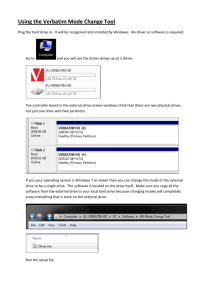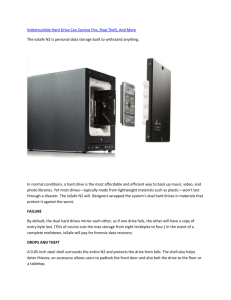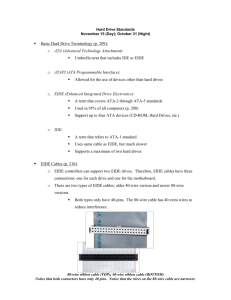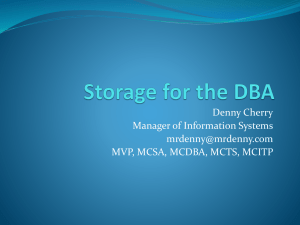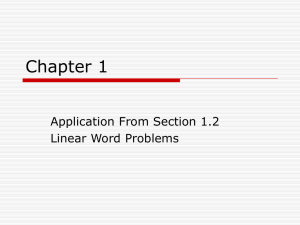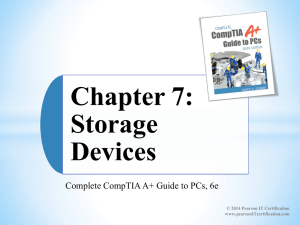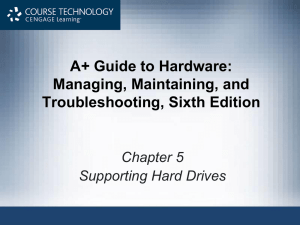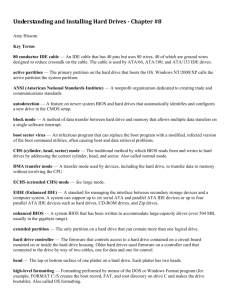CompTIA A+ 801: Hard Drive Technologies Answer Key
advertisement
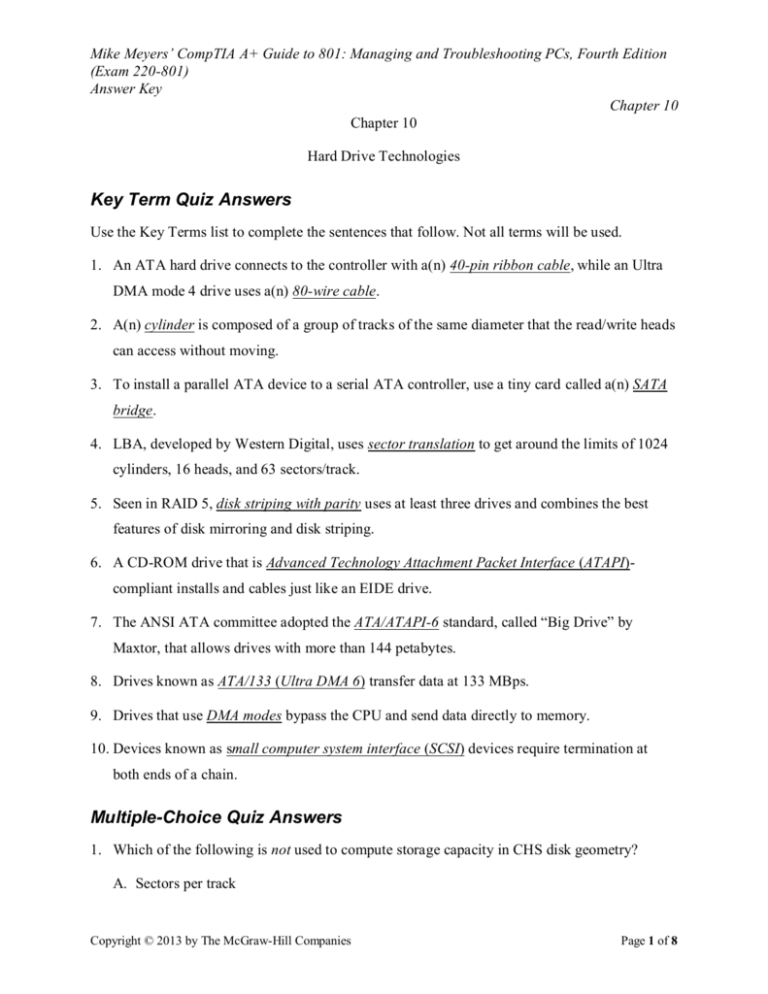
Mike Meyers’ CompTIA A+ Guide to 801: Managing and Troubleshooting PCs, Fourth Edition (Exam 220-801) Answer Key Chapter 10 Chapter 10 Hard Drive Technologies Key Term Quiz Answers Use the Key Terms list to complete the sentences that follow. Not all terms will be used. 1. An ATA hard drive connects to the controller with a(n) 40-pin ribbon cable, while an Ultra DMA mode 4 drive uses a(n) 80-wire cable. 2. A(n) cylinder is composed of a group of tracks of the same diameter that the read/write heads can access without moving. 3. To install a parallel ATA device to a serial ATA controller, use a tiny card called a(n) SATA bridge. 4. LBA, developed by Western Digital, uses sector translation to get around the limits of 1024 cylinders, 16 heads, and 63 sectors/track. 5. Seen in RAID 5, disk striping with parity uses at least three drives and combines the best features of disk mirroring and disk striping. 6. A CD-ROM drive that is Advanced Technology Attachment Packet Interface (ATAPI)compliant installs and cables just like an EIDE drive. 7. The ANSI ATA committee adopted the ATA/ATAPI-6 standard, called “Big Drive” by Maxtor, that allows drives with more than 144 petabytes. 8. Drives known as ATA/133 (Ultra DMA 6) transfer data at 133 MBps. 9. Drives that use DMA modes bypass the CPU and send data directly to memory. 10. Devices known as small computer system interface (SCSI) devices require termination at both ends of a chain. Multiple-Choice Quiz Answers 1. Which of the following is not used to compute storage capacity in CHS disk geometry? A. Sectors per track Copyright © 2013 by The McGraw-Hill Companies Page 1 of 8 Mike Meyers’ CompTIA A+ Guide to 801: Managing and Troubleshooting PCs, Fourth Edition (Exam 220-801) Answer Key Chapter 10 B. Tracks C. Heads D. Cylinders Answer: B 2. Which level of RAID is disk striping with distributed parity? A. RAID 0 B. RAID 1 C. RAID 5 D. RAID 6 Answer: C 3. Counting both channels, what is the maximum number of drives/devices that EIDE can support? A. One B. Two C. Seven D. Four Answer: D 4. Which of the following is not true about cable select? A. Both drives/devices should be set for cable select. B. Cable select requires a special cable with a pinhole through one wire. C. The colored stripe on the ribbon cable should align with pin 1 on the controller and drive. D. Position of the drives on the cable does not matter. Answer: D 5. If you install two IDE drives on the same cable, how will the computer differentiate them? Copyright © 2013 by The McGraw-Hill Companies Page 2 of 8 Mike Meyers’ CompTIA A+ Guide to 801: Managing and Troubleshooting PCs, Fourth Edition (Exam 220-801) Answer Key Chapter 10 A. The CMOS setup allows you to configure them. B. You must set jumpers to determine which drive functions as master and which functions as slave. C. You will set jumpers so each drive has a unique ID number. D. The drives will be differentiated by whether you place them before or after the twist in the ribbon cable. Answer: B 6. What was the maximum hard drive size allowed by BIOS routines for the original AT command set? A. 528 MB B. 1024 MB C. 504 MB D. 1028 MB Answer: C 7. Which of the following terms does not describe parallel ATA devices? A. IDE B. EIDE C. SCSI D. ATA Answer: C 8. Shelby wants to add a 500-GB hard drive to her computer. Which of the following will allow her to do so? A. CHS B. LBA Copyright © 2013 by The McGraw-Hill Companies Page 3 of 8 Mike Meyers’ CompTIA A+ Guide to 801: Managing and Troubleshooting PCs, Fourth Edition (Exam 220-801) Answer Key Chapter 10 C. ECHS D. INT13 Answer: D 9. Which of the following techniques provides redundancy by using two disks and two controllers? A. Drive mirroring B. Drive duplexing C. Disk striping D. Disk striping with parity Answer: B 10. How many wires does an Ultra DMA ATA cable have? A. 24 B. 34 C. 40 D. 80 Answer: D 11. Billy just installed a second hard drive, but the autodetection utility in CMOS does not detect it. Sara told him he probably has the jumpers set incorrectly or forgot to connect the Molex power connector. John told him his new hard drive is probably bad and he should return it. Who is probably correct, Sara or John? A. Sara is correct. B. John is correct. C. Neither is correct. D. Either John or Sara may be correct. Copyright © 2013 by The McGraw-Hill Companies Page 4 of 8 Mike Meyers’ CompTIA A+ Guide to 801: Managing and Troubleshooting PCs, Fourth Edition (Exam 220-801) Answer Key Chapter 10 Answer: D 12. Which of the following is not an advantage of serial ATA (SATA)? A. It is hot-swappable. B. Thinner cables provide better airflow inside the case. C. SATA provides faster data throughput than PATA. D. SATA cables must be shorter than PATA cables. Answer: D 13. What standard did the ANSI ATA committee adopt that increased disk storage capacity to more than 144 petabytes? A. ATA/ATAPI-6 B. LBA C. INT13 D. ECHS Answer: A 14. Which of the following can SSDs use to retain data integrity when a system loses power or is turned off? A. DRAM B. RAM drive C. NAND D. SDRAM Answer: C 15. Which of the following represent common solid-state drive form factors? A. AT, ATX, and BTX B. 8-inch, 2.5-inch, and 5.25-inch Copyright © 2013 by The McGraw-Hill Companies Page 5 of 8 Mike Meyers’ CompTIA A+ Guide to 801: Managing and Troubleshooting PCs, Fourth Edition (Exam 220-801) Answer Key Chapter 10 C. 1.8-inch, 2.5-inch, and 3.5-inch D. IEEE 1394, USB, and SCSI Answer: C Essay Quiz Answers 1. Discuss at least three advantages of serial ATA over parallel ATA. Answer: Among the most important advantages of serial ATA are the ability to hot-swap drives or devices, better airflow through use of the seven-wire cable, longer cable length (up to 1 meter for SATA instead of 18 inches for PATA), faster data transfer through serial bursts, and backward compatibility with PATA devices through the use of a SATA bridge. 2. Compare and contrast hardware and software RAID implementations. Answer: Software RAID, built-in to operating systems such as Windows Server 2008, Windows Server 2008 R2, or available from third-party vendors, is inexpensive to set up because it does not require special controllers. Disk Management in Windows XP, Windows Vista, and Windows 7 can do RAID 0, but not 1 or 5. With software RAID, the OS controls the RAID functions, often resulting in slowdowns because the OS is overworked. Hardware RAID, whether SCSI, ATA, or SATA, requires a controller chip that handles the RAID functions. One advantage of hardware RAID is the ability to hot-swap a bad drive without disturbing the OS. Hardware RAID also offers more RAID levels than software RAID and is the preferred choice in spite of the extra cost. 3. Your friend Blaine has a Core i5 computer with a great video card. Currently, it has only a 320-GB hard drive and a CD-RW drive. Because he’s interested in video, he knows he needs more storage capacity and wants to add a second hard drive. What advice will you give him about selecting a new hard drive? Answer: Blaine could install either an ATA or a SCSI hard drive. Dollar for performance and capacity today, he should go with a SATA hard drive over a PATA or SCSI. Video requires massive space, so the best option is to search for the current sweet spot on price per terabyte. If it costs $50 for a 1-TB drive, for example, but $150 for a 1.5-TB drive, he would Copyright © 2013 by The McGraw-Hill Companies Page 6 of 8 Mike Meyers’ CompTIA A+ Guide to 801: Managing and Troubleshooting PCs, Fourth Edition (Exam 220-801) Answer Key Chapter 10 be better off taking the smaller drive at this time. That sweet spot will vary depending on when your students are doing this lab. For performance, the student should look at spindle speed and cache on the drive (or even invest in a solid-state drive). A 10,000-RPM drive with a 32-MB cache, for example, will outperform a 7200-RPM drive with the same amount of cache. 4. Hard drives include other features and characteristics not included in this chapter. Choose one of the following topics and use the Internet to define and explain it to the class. Zone bit recording “Pixie dust” hard drives Answer: Zone bit recording is a technique that places different numbers of sectors on different tracks, with the outer tracks having higher recording density than the inner tracks. It results in higher capacity drives that are more stable throughout. Both ATA and SCSI drives use zone bit recording. Technically called antiferromagnetically coupled (AFC) media, “pixie dust” hard drives were invented by IBM. These drives used a thin layer of ruthenium inside the hard drives to enable data to be packed more densely and thus dramatically increased the storage capacity of the drives. 5. Your office is about to purchase ten new portable computers for the sales force and needs a recommendation. Prepare a short essay that compares and contrasts platter-based and solidstate drives so your boss can pick what’s best for the staff. Answer: The student should point out the good and bad points of the two technologies. Platter-based drives give you the most capacity for your money, and the technology is stable. On the other hand, solid-state drives give you better performance, no moving parts, and lower electricity use. The cost per gigabyte is much higher with SSDs over HDDs. Copyright © 2013 by The McGraw-Hill Companies Page 7 of 8 Mike Meyers’ CompTIA A+ Guide to 801: Managing and Troubleshooting PCs, Fourth Edition (Exam 220-801) Answer Key Chapter 10 Cross Check Answers Molex Connectors Molex connectors have four wires: two black ground wires, a 5-volt red wire, and a 12-volt yellow wire. The Molex connector is beveled on two corners, so it only inserts (easily) one way into a socket. If you force it into the socket and apply power, you’ll toast whatever device you’ve plugged it into, as the 12-volt circuit fries all the 5-volt electronics in its path. Copyright © 2013 by The McGraw-Hill Companies Page 8 of 8



